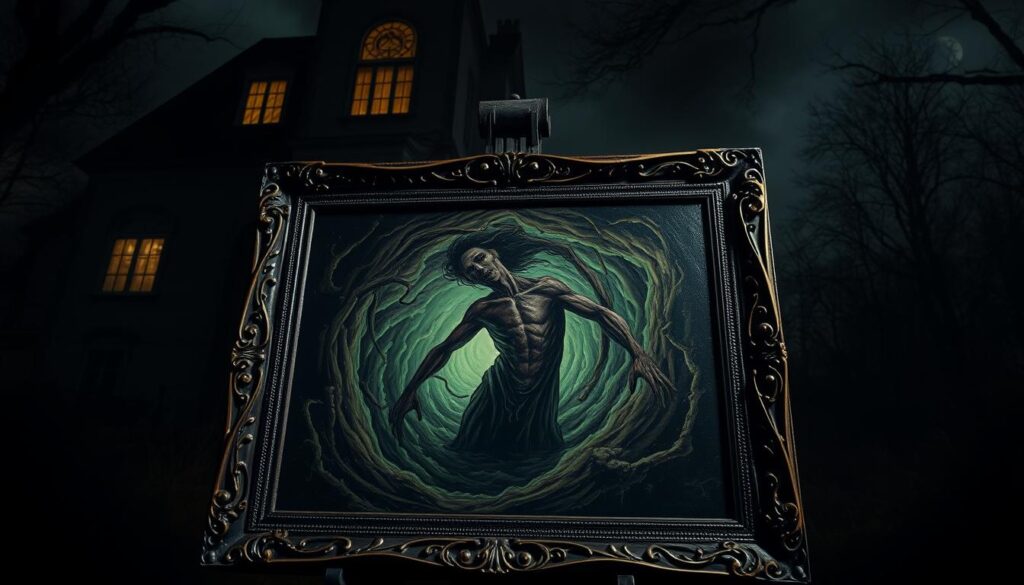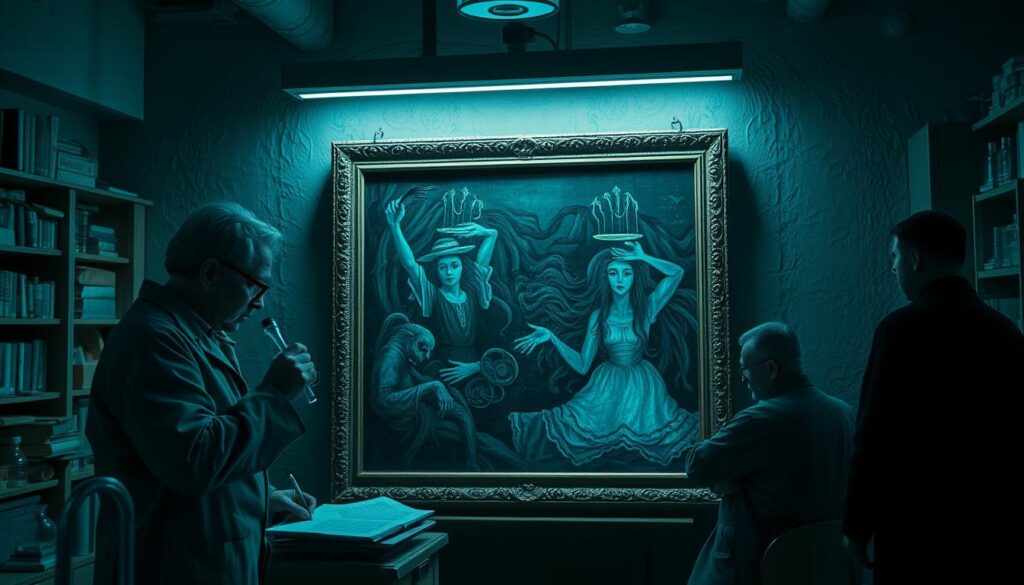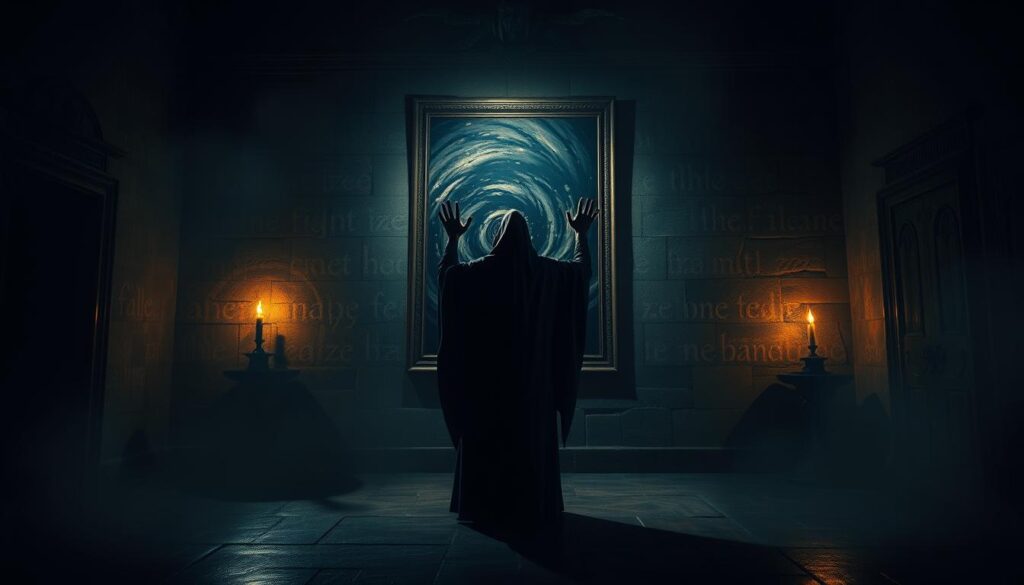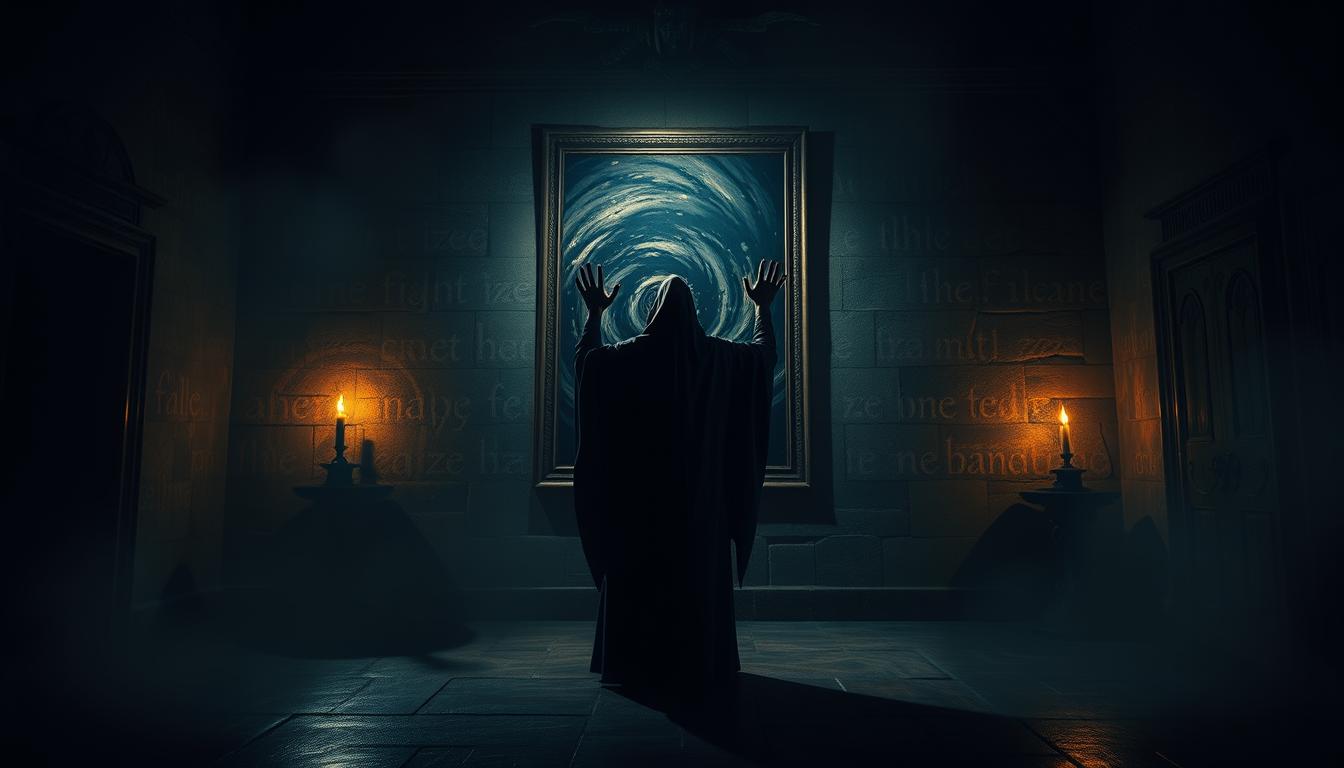Many people find the idea of cursed artwork fascinating. They believe some paintings can bring bad luck to their owners. This belief comes from old superstitions about art.

The connection between art and superstition is deep. Many cultures think certain objects, like paintings, can be cursed. This has led to many stories and legends about cursed artwork. The idea that a painting can harm its owner is both interesting and a bit scary.
Introduction to Cursed Artwork
There’s a lot to learn about cursed artwork. It covers the history of haunted paintings and the cultural views on cursed objects. Whether you love art, the supernatural, or just find this topic interesting, you’ll find it captivating.
Key Takeaways
- The concept of cursed artwork is rooted in ancient beliefs and superstitions surrounding art and superstition.
- Haunted paintings are a type of cursed artwork that is believed to bring misfortune to their owners.
- The relationship between art and superstition is complex and influenced by cultural perspectives.
- Cursed artwork can have a significant impact on the lives of collectors and enthusiasts.
- Understanding the history and cultural context of cursed artwork is essential to appreciating its significance.
- The idea of cursed artwork raises important questions about the power of art to influence our lives.
The Mysterious History of Cursed Artwork
Looking into art history, we see that cursed artwork has always fascinated us. From ancient times to today, superstition in art has shaped how we see some paintings and objects. The idea that art can have supernatural powers, good or bad, has captivated many.
Exploring the history of this belief, we must look at cultural beliefs about cursed objects passed down through generations. These beliefs come from many sources, like religion, folklore, and personal stories. By studying famous cases of haunted or cursed paintings, we learn about the psychological and social sides of these beliefs.
- Ancient mythologies, where gods and goddesses could curse or bless art
- Medieval legends, telling of haunted paintings and sculptures to explain strange events
- Modern-day stories, where people say strange things happened after seeing certain art
By looking at these examples and understanding cultural perspectives on cursed objects, we get a deeper look at human beliefs about art and the supernatural. It shows how complex and sometimes contradictory our beliefs can be.
When a Painting Brings Misfortune to Its Owner: Documented Cases
Many documented cases of cursed artwork have been reported throughout history. These paintings were believed to bring art and misfortune to their owners. They were often linked to mysterious accidents, unexplained events, and tragic losses.
Some famous examples include the “Portrait of Madame X” by John Singer Sargent. It was thought to bring bad luck to its owners. Another example is “The Anguished Man” by Paul Booth, painted with blood and ashes. These stories show the dark side of owning cursed artwork.
Here are some key points to consider when looking at documented cases of cursed artwork:
- Many cases involve unexplained events or accidents that occur after the painting is acquired or displayed.
- Some paintings are believed to have been created using unusual or sinister methods, such as the use of blood or ashes.
- The owners of these paintings often report feeling a sense of unease or dread when in the presence of the artwork.
While the idea of cursed artwork may seem far-fetched, these documented cases show the complex relationship between art and humans. By studying these cases, we can better understand how art can shape our views and lives.
The Psychology Behind Cursed Paintings
The belief in cursed paintings comes from many psychological factors. One key reason is the psychology of superstition. This is when people believe in supernatural reasons for things. They might think a painting is cursed, even if it’s not true.
Another factor is the nocebo effect. This happens when someone expects something bad to happen and it does. With cursed paintings, people might feel bad or have bad things happen because they think the painting is cursed.
Lastly, mass hysteria plays a role. When many people believe the same thing, it can make it seem true. This can make the fear around a painting real, creating a cycle of fear and belief.
Scientific Explanations for “Cursed” Artwork
Exploring rationalizing superstition around cursed artwork, science offers key insights. By looking into natural causes, we grasp the strange happenings tied to these pieces. For example, a painting might seem to change colors or show odd patterns due to aging or environmental changes.
Some possible scientific explanations for cursed artwork include:
- Natural patina or aging processes that alter the appearance of the artwork
- Environmental factors, such as humidity or light exposure, that affect the artwork’s condition
- Psychological factors, including the power of suggestion and the nocebo effect, that influence people’s perceptions of the artwork

By diving into these scientific explanations for cursed artwork, we gain a clearer view. This understanding helps us to better rationalize superstition and see these mysteries with a more thoughtful eye.
Famous Artists Associated with Unfortunate Events
Many famous artists have faced tragedy and unfortunate events. These experiences have added to the myth of cursed artwork. Their lives show how art, artists, and beliefs are intertwined.
Vincent van Gogh struggled with mental illness and poverty. Frida Kahlo was hurt in a bus accident, leading to chronic pain. These events influenced their art, with themes of suffering and resilience appearing in their work.
Art and tragedy are not just historical. Today, artists face tragic events too. This has made people curious about cursed artwork again. By looking at these artists’ lives and work, we learn more about art and tragedy.
The Tragic Tales Behind Masterpieces
- Vincent van Gogh’s Starry Night was painted while he was in an asylum
- Frida Kahlo’s The Broken Column shows her physical and emotional pain
- Other artists, like Edvard Munch and Egon Schiele, also showed their struggles in their art
Contemporary Cases and Modern Artists
In recent years, many artists have faced unfortunate events. This has made people interested in cursed artwork again. By looking at these cases, we see how art and tragedy keep evolving and shaping our views of art’s role in society.
Signs Your Artwork Might Be Bringing Bad Luck
Many believe that certain artwork can bring bad luck and art into their lives. There’s no scientific proof, but people notice strange things. They see unexplained noises, movements, or changes in their surroundings.
Some folks share personal experiences with artwork that they think is unlucky. These stories can be small or big. Some feel a weird, unsettling vibe when near the artwork.
- Unexplained noises or movements
- Changes in temperature or lighting
- Feelings of unease or discomfort
These signs might come from the power of suggestion or thenocebo effect. But for those who believe, these signs mean the artwork is bringingbad luck and art into their lives.
The Art Market’s Response to “Cursed” Paintings
The art market has a fascinating response to cursed paintings. Some collectors and galleries see the superstition as a marketing tool. This boosts interest and value.
When a painting is seen as cursed, its value can go up. This is because some collectors find the mystery and intrigue appealing. It shows how superstition can influence our views of art.
Some cursed paintings have sold for a lot at auction. The superstition around them plays a big role in their value. This shows how the art market can embrace and even profit from superstition.
In conclusion, the art market’s view on cursed paintings is complex. It’s influenced by psychology, culture, and economics. As the art market grows, it will be interesting to see how it handles these paintings and superstition.
Protecting Yourself from Potentially Harmful Artwork
If you think cursed artwork can harm you, it’s key to protect yourself. Getting expert advice and learning about spiritual cleansing is crucial. This way, you can keep yourself safe from harmful artwork.
Spiritual cleansing is vital to protect against cursed artwork. It cleanses the artwork and the area around it, stopping negative energy. Also, getting a professional assessment helps figure out if the artwork is real and if it’s harmful. Experts can help you understand the artwork better and protect yourself.

- Research the artwork’s history and provenance
- Consult with experts in the field of spiritual cleansing and professional assessment
- Take precautions when handling or displaying the artwork
By following these steps, you can keep yourself safe around potentially harmful artwork. Remember, it’s all about spiritual cleansing, professional assessment, and being careful.
Legal Implications of Selling “Cursed” Art
Selling haunted paintings comes with legal complexities. In the United States, laws cover the sale of artwork. This includes rules on disclosure and liability. Sellers must tell buyers about any known problems with the artwork, like curses.
Both buyers and sellers face important legal considerations. Key points include:
- Disclosure requirements: Sellers must share any known issues with the artwork, including curses.
- Liability concerns: Sellers could be held responsible if the artwork is defective or causes harm.
- Warranty and refund policies: Buyers should know about any warranties or refunds for defective or cursed artwork.
It’s vital to understand the legal side of cursed artwork. Knowing the laws helps buyers and sellers make smart choices.
The idea of cursed artwork is fascinating but needs a careful look. By understanding the legal aspects, we can deal with the challenges of cursed art. This way, we can make better choices when buying and selling art.
The Role of Museums in Handling Controversial Pieces
Museums are key in keeping and showing off artwork, even the controversial or cursed ones. They face a challenge: educating the public while keeping the artwork safe and respected. This balance is crucial.
To meet this challenge, museums use safety protocols. These include special cases, limited access, and watching over the artwork’s environment. This helps protect both the artwork and the visitors.
When dealing with controversial pieces, museums consider a few things:
- Creating educational programs to help people understand the artwork
- Dealing with conservation issues like damage or deterioration
- Handling and storing the artwork in a way that honors its cultural and historical value
Museums take a careful and detailed approach to handle these pieces. This way, they promote a deeper understanding and appreciation of the artwork. They also make sure it’s preserved for the future.
Conclusion: Separating Fact from Fiction in Art-Related Misfortune
As we wrap up our look into “cursed” artwork, it’s key to know what’s real and what’s not. Legends and myths have swirled around some art pieces for ages. But, the truth is often more detailed.
Many stories of bad luck tied to these artworks stem from our minds. Things like the power of suggestion and the nocebo effect play a big role. These are psychological factors.
But, there’s a real side to the story too. The lives of famous artists sometimes show a clear link between their art and personal struggles. The art world also reacts to these “cursed” paintings, showing their real impact.
In the end, the connection between art and misfortune is complex. By keeping an open mind, we can grasp the intricate relationship between art and the unknown. This way, we can tell fact from fiction and delve into the mysteries of “cursed” artwork.
FAQ
What is the history behind the belief in cursed artwork?
The idea of cursed artwork comes from ancient times. In ancient Egypt, some paintings were seen as having supernatural powers. This belief has grown over the centuries, captivating people worldwide.
Can a painting really bring misfortune to its owner?
Yes, many stories tell of paintings causing accidents or bad luck. These tales are often debated, but the belief in cursed art remains strong.
What psychological factors contribute to the belief in cursed paintings?
Our minds can play tricks on us, making us believe in cursed paintings. The power of suggestion and mass hysteria can influence our thoughts. This leads to the idea that some art is cursed.
Are there scientific explanations for the phenomena associated with cursed artwork?
Indeed, science offers explanations for the strange happenings around cursed paintings. Often, these events have natural causes or are just coincidences. Science helps us see things differently.
Which famous artists have been associated with unfortunate events?
Famous artists like Leonardo da Vinci and Pablo Picasso have faced tragic events. These stories add to the mystery of cursed art, showing the complex bond between art and belief.
How can I tell if my artwork might be bringing bad luck?
Look out for strange occurrences like odd noises or temperature changes. But remember, just because something happens, it doesn’t mean the art is cursed. Always get a professional opinion.
What are the legal implications of selling “cursed” art?
Selling cursed art is tricky legally. Sellers must share the artwork’s history, and there’s a risk of being sued if it’s believed to cause harm. Knowing the law is key for both sellers and buyers.
How do museums handle controversial or potentially cursed pieces?
Museums have special plans for handling art that’s seen as cursed. They educate the public and take care of the art. It’s a big responsibility in the art world.
Source
https://observer.com/2024/10/haunted-paintings-munch-beksinski-landseer-cursed-artwork/
https://lifestyleasia-onemega.com/haunting-canvases-4-famous-cursed-artworks-including-a-juan-luna
https://en.wikipedia.org/wiki/List_of_reportedly_haunted_paintings
